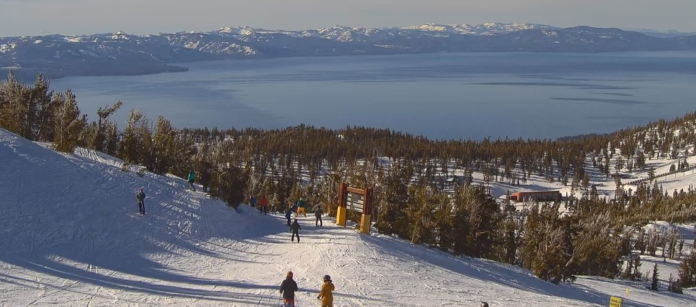A powerful winter storm system is expected to hammer California later this week, bringing 5 to 10 feet of new snow between Thursday and Sunday to the Sierra Nevada, white-out conditions and the potential for extended highway closures.
“If people are not already up here by Thursday morning, do not come,” said Andrew Schwartz, lead scientist at the UC Central Sierra Snow Lab at Donner Summit near Lake Tahoe. “It’s a shelter-in-place situation. People up here are buying fuel today for backup generators and boarding up their windows. It’s like watching people prepare for a hurricane.”
On Tuesday, the National Weather Service issued a blizzard warning — its first of the year — for the Northern and Central Sierra Nevada. The warning extends from 4 a.m. Thursday to 10 a.m. Sunday from Lassen and Shasta counties through Lake Tahoe to Tuolumne and Mono counties near Yosemite National Park.
Snow will begin falling Thursday, and become most extreme on Friday at amounts of 2 to 4 inches an hour, posing “near to impossible” conditions for drivers, winds up to 65 mph and power outages, the National Weather Service warned, with extended road closures possible on Interstate 80 and Highway 50, the main two routes that Bay Area residents use to go to Lake Tahoe area ski resorts.
“This will be the coldest system of the season so far, with the most snow,” said Courtney Carpenter, a meteorologist with the National Weather Service in Sacramento.
Donner Pass along I-80 is expected to get 6 to 8 feet of new snow through Sunday.
“It’s really going to be dangerous to impossible to travel over the weekend,” she added.
The Bay Area will be spared much of the fury from the storm, a cold low-pressure system moving in from the Gulf of Alaska. Moderate rain is forecast Thursday, Friday and Saturday, with about half an inch expected each day for most Bay Area cities before dry conditions return Sunday and Monday.
An inch or two of snow could fall on some of the Bay Area’s highest peaks by Saturday, including Mount Hamilton and Mount Diablo, forecasters said.
The powerful blizzard is the latest and most dramatic example of a winter that started slow but has steadily increased, improving California’s water picture with every passing week, and all but guaranteeing that there will be few, if any water restrictions this summer for most communities in the state.
On Jan. 1, the statewide Sierra snowpack — the source of nearly one-third of California’s water supply — was just 28% of its historical average. After a wet February, it rebounded in two months to 82% on Tuesday. That number is very likely to go above 100% by Monday.
“We definitely started the winter off on the warmer and drier side,” said Jeanine Jones, interstate resources manager for the California Department of Water Resources. “Then things started picking up. The month of February was a big help in moving the snowpack numbers along.”
Californians have suffered through serious droughts in eight of the past 12 years. The dry conditions, exacerbated by climate change, have brought heat waves, urban and farm water restrictions and huge wildfires over the last decade.
The state’s most recent drought, from 2020 to 2022, ended last year when dozens of atmospheric river storms left the Sierra Nevada with its biggest snowpack in 40 years. Those storms, and the melting snow, also filled reservoirs around the state, many of which remain at high levels now.
On Tuesday, Shasta and Oroville, the two largest reservoirs in California, and linchpins of the water supply for more than 20 million people from the Bay Area to San Diego, each were 84% full.
Operators at some large dams have been releasing water to preserve space and reduce flood risk in case huge storms hit the state, Jones said. But that will change soon as the winter winds down heading into April.
“As we get later into the spring, the flood-control requirements will be lifted and reservoirs will be storing snowmelt runoff,” she said.
The wet February has also sent precipitation levels in Northern and Southern California to healthy totals. On Tuesday, San Jose was at 130% of its historical rainfall average for late February, San Francisco was at 116%, Sacramento was at 106% and Oakland was at 86%.
Farther south, Santa Barbara was at 159% of normal rainfall, Los Angeles 170% and San Diego 138%.
Heavy storms in recent weeks have created a temporary lake in Death Valley, usually the hottest spot in the United States. The waist-deep lake has drawn tourists with kayaks and paddle boards, creating a rare scene on the site of Lake Manly, a former lake in the low-lying Badwater Basin in Death Valley National Park that evaporated tens of thousands of years ago.
So far, the winter has unfolded in a very advantageous way statewide, Schwartz said. Flooding has been minimal, and two back-to-back winters with above-average to average rainfall mean drought conditions aren’t in the cards for 2024.
“This is the year that we wanted to have after last year,” he said. “We aren’t looking at such a deep snow pack that it is going to pose flooding issues. And we aren’t looking at a moisture deficit. It’s kind of the best of both worlds.”
Biggest storm of the year to bring up to 10 feet of snow and “near to impossible” travel conditions to Sierra this week
Recent Comments
on Army vs. Coastal Carolina live stream, how to watch online, CBS Sports Network channel finder, odds
on AL Rookie of the Year Julio Rodriguez Spreads Joy and Sportsmanship to the Youth of Loma de Cabrera
on After UFC Fallout, Conor McGregor Offers a Valuable Piece of Advice to Free Agent Francis Ngannou
on Dubai International Airport sees 41.6 million passengers in first half of year, more than in 2019
on Devout athletes find strength in their faith. But practicing it and elite sports can pose hurdles
on Despite strong Lunar New Year holiday data, consumer spending in China isn’t roaring back just yet
on Dave Portnoy: Taylor Swift’s security should ‘drag Kim Kardashian to jail’ if she attends Eras Tour
on CONCEPT ART: New Details Revealed for Disney Cruise Line Lookout Cay at Lighthouse Point Destination
on “Completely Knocked Me Out”: Rob Lowe Recalls Boxing Match With Tom Cruise On 1983 Brat Pack Classic
on CBS Sports, Serie A announce new TV rights deal; Paramount+ to air over 400 Italian soccer matches
on Cam Newton’s Violent Public Incident Draws Hilarious Reaction From 3x All-Star: “Where Do I Sign Up
on Boston College vs. Army live stream, how to watch online, CBS Sports Network channel finder, odds
on Angel Reese Launches Foundation Dedicated To Empowering Women Through Sports & Financial Literacy
on A weaker dollar, skyrocketing prices and ‘record’ visitor numbers: Good luck in Europe this summer




